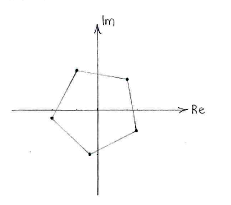Solution 3.3:2c
From Förberedande kurs i matematik 2
(Ny sida: {{NAVCONTENT_START}} <center> Bild:3_3_2c-1(2).gif </center> {{NAVCONTENT_STOP}} {{NAVCONTENT_START}} <center> Bild:3_3_2c-2(2).gif </center> {{NAVCONTENT_STOP}}) |
m |
||
| (4 intermediate revisions not shown.) | |||
| Line 1: | Line 1: | ||
| - | {{ | + | We write <math>z</math> and the right-hand side <math>-1-i</math> in polar form |
| - | < | + | |
| - | {{ | + | {{Displayed math||<math>\begin{align} |
| - | {{ | + | z &= r(\cos\alpha + i\sin\alpha)\,,\\[5pt] |
| - | < | + | -1-i &= \sqrt{2}\Bigl(\cos\frac{5\pi}{4} + i\sin\frac{5\pi}{4}\Bigr)\,\textrm{.} |
| - | {{ | + | \end{align}</math>}} |
| + | |||
| + | Using de Moivre's formula, the equation can now be written as | ||
| + | |||
| + | {{Displayed math||<math>r^5(\cos 5\alpha + i\sin 5\alpha) = \sqrt{2}\Bigl(\cos \frac{5\pi}{4} + i\sin\frac{5\pi}{4}\Bigr)\,\textrm{.}</math>}} | ||
| + | |||
| + | If we identify the magnitude and argument on both sides, we get | ||
| + | |||
| + | {{Displayed math||<math>\left\{\begin{align} | ||
| + | r^5 &= \sqrt{2}\,,\\[5pt] | ||
| + | 5\alpha &= \frac{5\pi}{4} + 2n\pi\,,\quad\text{(n is an arbitrary integer).} | ||
| + | \end{align}\right.</math>}} | ||
| + | |||
| + | (The arguments <math>5\alpha</math> and <math>5\pi/4</math> can differ by a multiple of <math>2\pi</math> and still correspond to the same complex number.) | ||
| + | |||
| + | This gives that | ||
| + | |||
| + | {{Displayed math||<math>\left\{\begin{align} | ||
| + | r &= \sqrt[5]{2} = \bigl(2^{1/2}\bigr)^{1/5} = 2^{1/10}\,,\\[5pt] | ||
| + | \alpha &= \frac{1}{5}\Bigl(\frac{5\pi}{4}+2n\pi\Bigr) = \frac{\pi}{4} + \frac{2n\pi}{5}\,,\quad\text{(n is an arbitrary integer).} | ||
| + | \end{align}\right.</math>}} | ||
| + | |||
| + | If we investigate the argument <math>\alpha</math> more closely, we see that it assumes essentially only five different values, | ||
| + | |||
| + | {{Displayed math||<math>\frac{\pi}{4}</math>, <math>\quad\frac{\pi}{4}+\frac{2\pi}{5}</math>, <math>\quad\frac{\pi}{4}+\frac{4\pi}{5}</math>, <math>\quad\frac{\pi}{4}+\frac{6\pi}{5}\quad</math> and <math>\quad\frac{\pi}{4}+\frac{8\pi}{5}</math>}} | ||
| + | |||
| + | since these angle values then repeat to within a multiple of <math>2\pi</math>. | ||
| + | |||
| + | In summary, the solutions are | ||
| + | |||
| + | {{Displayed math||<math>z = 2^{1/10}\,\Bigl(\cos\Bigl(\frac{\pi}{4}+\frac{2n\pi}{5}\Bigr) + i\sin\Bigl(\frac{\pi}{4}+\frac{2n\pi}{5}\Bigr)\Bigr)\,,</math>}} | ||
| + | |||
| + | for <math>n=0</math>, <math>1</math>, <math>2</math>, <math>3</math> and | ||
| + | <math>4</math>. | ||
| + | |||
| + | [[Image:3_3_2_c.gif|center]] | ||
Current revision
We write \displaystyle z and the right-hand side \displaystyle -1-i in polar form
| \displaystyle \begin{align}
z &= r(\cos\alpha + i\sin\alpha)\,,\\[5pt] -1-i &= \sqrt{2}\Bigl(\cos\frac{5\pi}{4} + i\sin\frac{5\pi}{4}\Bigr)\,\textrm{.} \end{align} |
Using de Moivre's formula, the equation can now be written as
| \displaystyle r^5(\cos 5\alpha + i\sin 5\alpha) = \sqrt{2}\Bigl(\cos \frac{5\pi}{4} + i\sin\frac{5\pi}{4}\Bigr)\,\textrm{.} |
If we identify the magnitude and argument on both sides, we get
| \displaystyle \left\{\begin{align}
r^5 &= \sqrt{2}\,,\\[5pt] 5\alpha &= \frac{5\pi}{4} + 2n\pi\,,\quad\text{(n is an arbitrary integer).} \end{align}\right. |
(The arguments \displaystyle 5\alpha and \displaystyle 5\pi/4 can differ by a multiple of \displaystyle 2\pi and still correspond to the same complex number.)
This gives that
| \displaystyle \left\{\begin{align}
r &= \sqrt[5]{2} = \bigl(2^{1/2}\bigr)^{1/5} = 2^{1/10}\,,\\[5pt] \alpha &= \frac{1}{5}\Bigl(\frac{5\pi}{4}+2n\pi\Bigr) = \frac{\pi}{4} + \frac{2n\pi}{5}\,,\quad\text{(n is an arbitrary integer).} \end{align}\right. |
If we investigate the argument \displaystyle \alpha more closely, we see that it assumes essentially only five different values,
| \displaystyle \frac{\pi}{4}, \displaystyle \quad\frac{\pi}{4}+\frac{2\pi}{5}, \displaystyle \quad\frac{\pi}{4}+\frac{4\pi}{5}, \displaystyle \quad\frac{\pi}{4}+\frac{6\pi}{5}\quad and \displaystyle \quad\frac{\pi}{4}+\frac{8\pi}{5} |
since these angle values then repeat to within a multiple of \displaystyle 2\pi.
In summary, the solutions are
| \displaystyle z = 2^{1/10}\,\Bigl(\cos\Bigl(\frac{\pi}{4}+\frac{2n\pi}{5}\Bigr) + i\sin\Bigl(\frac{\pi}{4}+\frac{2n\pi}{5}\Bigr)\Bigr)\,, |
for \displaystyle n=0, \displaystyle 1, \displaystyle 2, \displaystyle 3 and \displaystyle 4.

